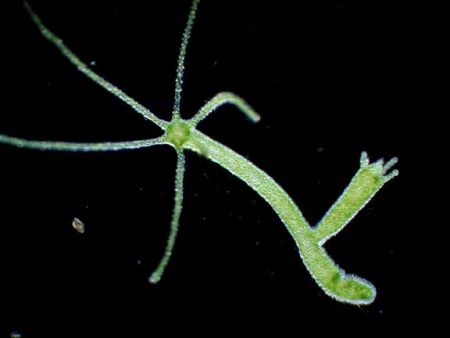Tonight on ABC1 you may have been lucky enough to watch “Life” narrated by David Attenborough. This, the first of three episodes, was about fish – their variety, feeding and reproductive behaviours, habitats and predators. It began with footage taken in southern Australian waters, of the weedy sea dragon, showing how the male and female court by ‘dancing’ then the female transfers the fertilized eggs to the male, who looks after them until they hatch. The tiny hatchlings wriggle free from the father’s belly-fold and begin to feed, with their yolk sac still attached. The anglerfish has another unusual method of reproduction, in which the male is ‘parasitic’ on the female. The tiny male embeds itself in the female and disintegrates into the female’s flesh, until all that is left is the testes.
Praying mantids exhibit another unusual method of reproduction, in which the male has a good chance of his head being bitten off during mating. If the male happens to lose his rigid grip from atop the female, he is at risk of sexual cannibalism – the female gets a nutritous meal as well as continued copulation, as the nerves that stop copulation are in the head, and the nerves that continue copulation are in the abdomen. Dragonflies and damselflies also display unusual courtship. Eggs may be deposited underwater, drilled into mud, carved into stems, or dropped while in flight.
The green spoonworm (Bonellia viridis) is another species in which the female dominates – in fact you are unlikely to find a male spoonworm at all. The spoonworms begin life as free-swimming larvae, which settle to the bottom of the Mediterranean Sea and slowly develop. If the larvae happen to settle on another female, the female releases a chemical that turns the larvae into a tiny male, which migrates through her mouth into the uterus and assumes a parasitic existence. The female can have up to twenty tiny males inside her genital sac, so she expends no energy looking for a mate, while the male benefits by having a safe and secure space, relying on the female for nutrition.
Marmosets…………..
In a recent article in The Age, “Cheating is risky, but worth it, for female finches”, Adam Carey writes about the reproductive strategies of the beautiful Gouldian Finches, which have an unusually high rate of intra-species incompatability. “Gouldian finches mate two to four times a day during breeding season, but given the opportunity, the female will covertly cuckold her mate, also going to great lengths to keep it a secret. Males will help to incubate eggs and feed chicks, unless the female’s infidelity becomes known, in which case he might abandon the brood.” So what motivates the female to take such a risk? Scientists believe that the female can choose genetically superior mates and maximizes her chance of conceiving healthy offspring by ‘cheating’ on her mate. A superior male can fertilize up to 75% of a female’s eggs, making even one copulation worthwhile.
Mating behaviour in animals – monogamy, polygamy, polygyny and polyandry.


















